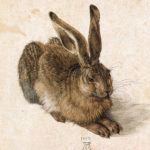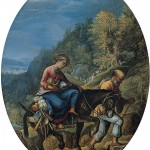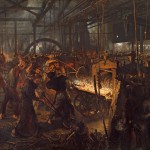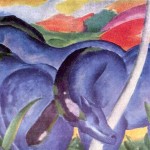I recently did a post on Opening the Door to Russian Art, so I thought I should follow it up with Opening the Door to German Art. There’s so much to discover in the arts that many people find the topic just too big. I find that a brief introduction is sometimes all a person needs to get started. So here’s a place to begin:
Albrecht Dürer
In an era abounding with complex Renaissance masterworks, Dürer’s gentle rabbit, with its slightly startled look, astonishes us. It’s created using a combination of watercolor and gauche, which is similar to watercolor, but opaque. The rabbit is painted with such detailed accuracy, it could appear in a scientific textbook. A simple rabbit was a surprising subject for an artist famed for imposing portraits, intricate altar paintings, and detailed allegorical engravings. His best-known work is also deceptively simple: a pen-and-ink drawing of the praying hands.
Adam Elsheimer
Adam Elsheimer painted usually on copper plates known as cabinet painting. Choosing religious topics and themes from Classical Antiquity, he filled his paintings with action. This small oval painting, though, is focused on the Holy Family fleeing across a rocky, yet scenic hill. The figures bend together, conveying their urgency. Elsheimer painted another, dramatic version of this theme in 1609, set in the deep of night. Painters influenced by Elsheimer include Rembrandt and Rubens.
Carl Spitweg
Spitzweg’s tender, detailed portrayal of everyday German life endears him to viewers, even today. His paintings harmonize with the fashionable movement known as Biedermeier, a restrained, elegant style that valued stability and domesticity in the aftermath of the Napoleonic Wars. His paintings convey a sense of intimacy and humor. He preferred gentle, even eccentric subjects to the dramatic Gothic themes popular with many of his contemporaries.
Adolph von Menzel
Menzel’s powerful, dark portrayal of the new industrial era shows just how dangerous life could be. In the bottom right corner, removed slightly from the heat, we see a child among the workers devouring their meager meals. What has been called a “demonic drama” of man and machine is broken only by dim light in the top third of the painting. This painting contrasts with his painting depicting Frederick the Great playing the flute in his gold-leafed Sanssouci palace.
Franz Marc
One of the most interesting of the German Expressionists, Marc used a basic theory of colors: blue for masculinity and spirituality, yellow for feminine joy, and red for violence. This painting was one of many bold, fantastic paintings of animals, including The Red Horse and The Yellow Cow. A founder of the avant-garde group known as The Blue Rider, Marc’s paintings reflected the conflicting forces that led to World War I. He served in that war, dying at the Battle of Verdun.
Now that we’ve opened the door to German Art, try exploring some more paintings by these same artists.



_-_WGA21686-1-150x150.jpg)




